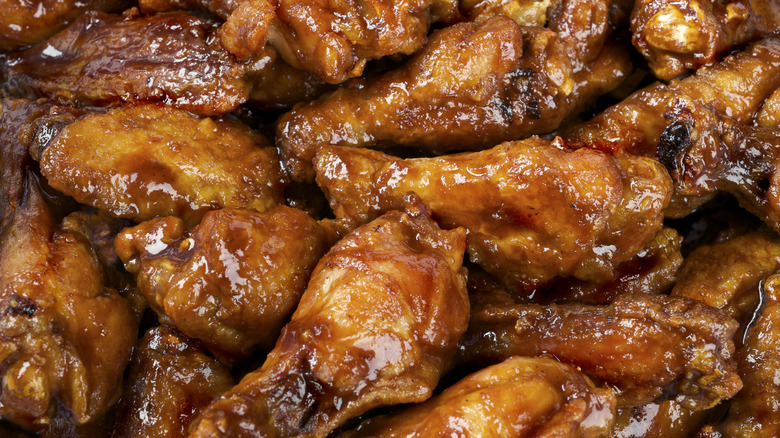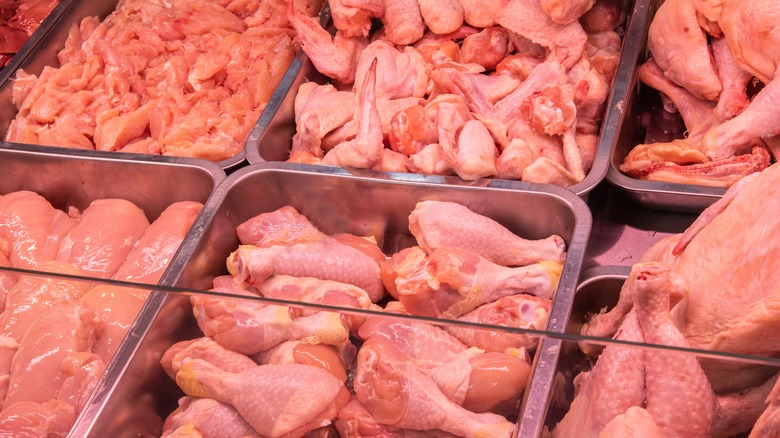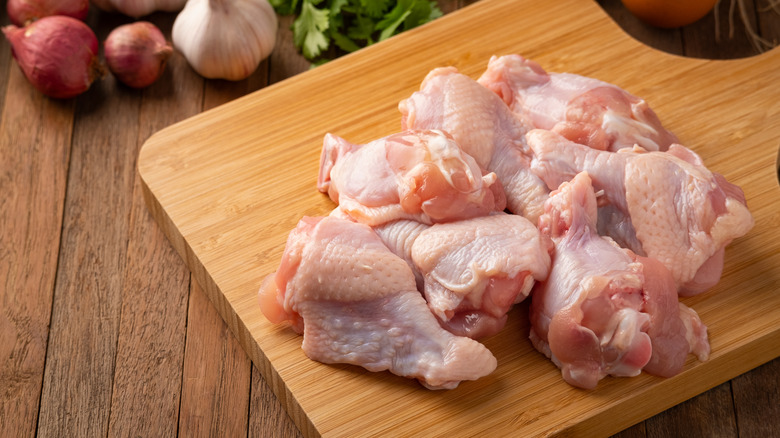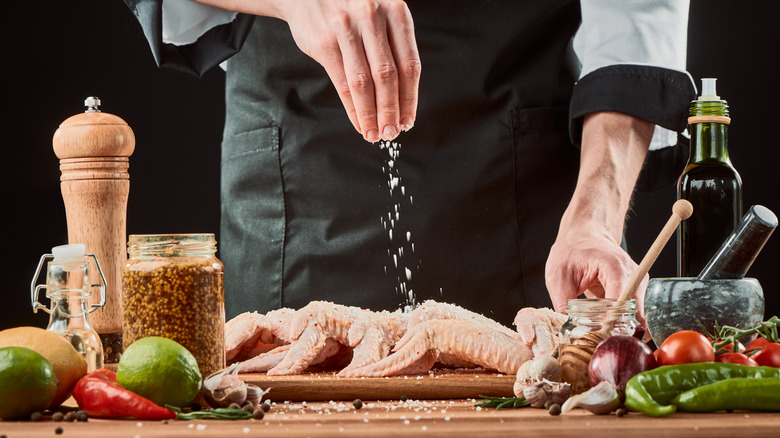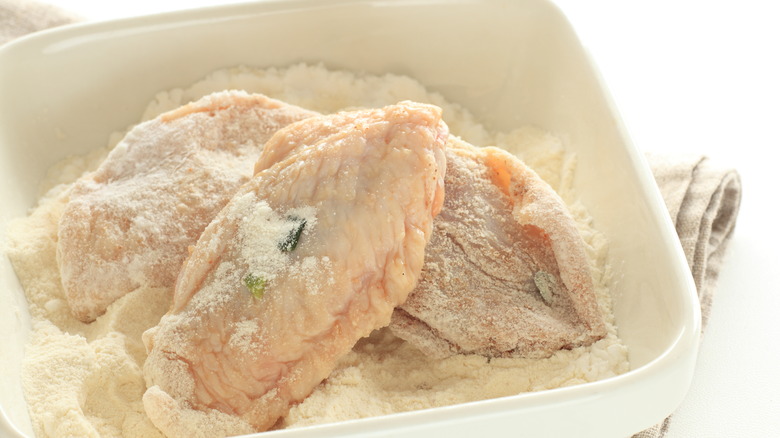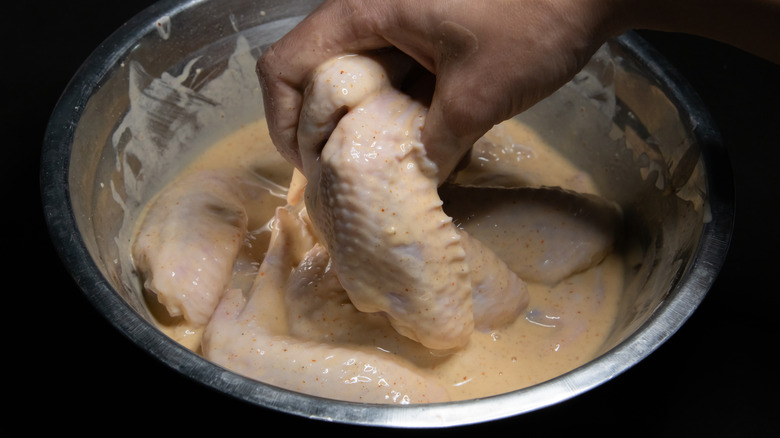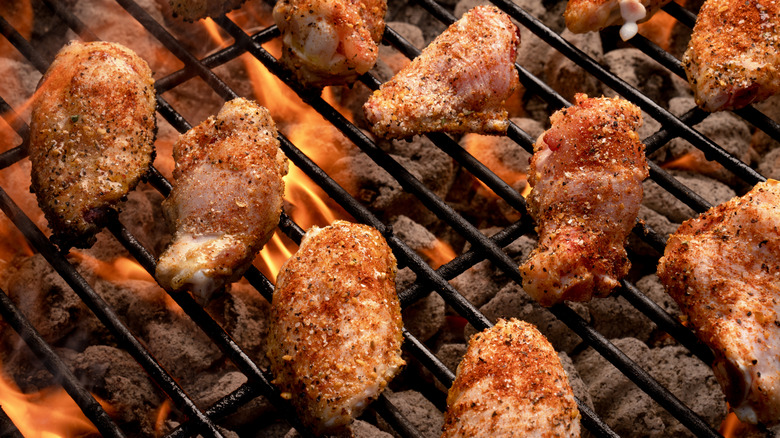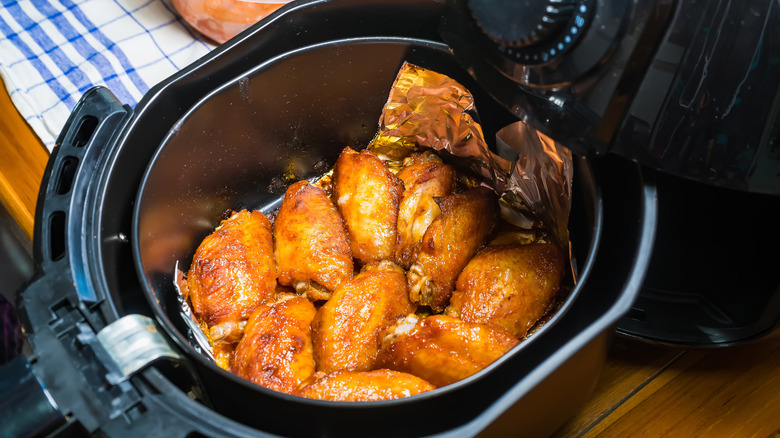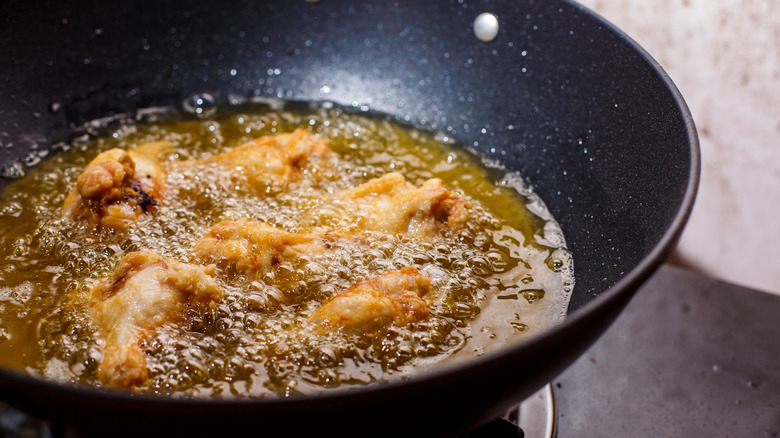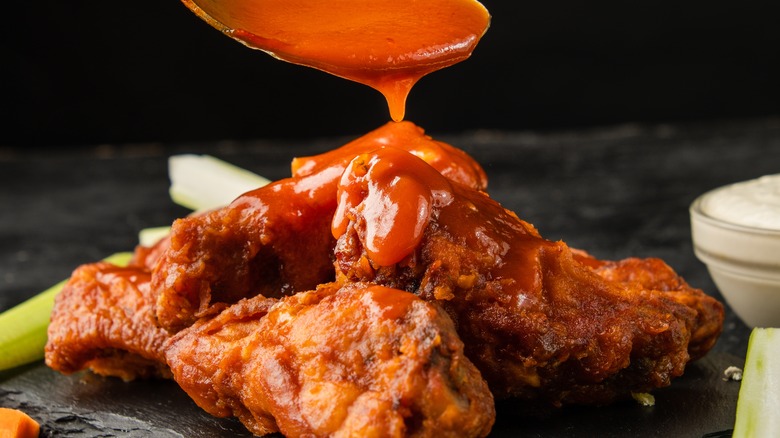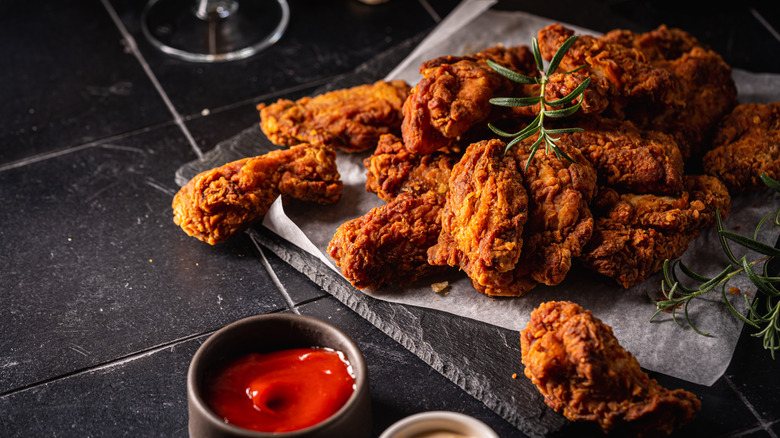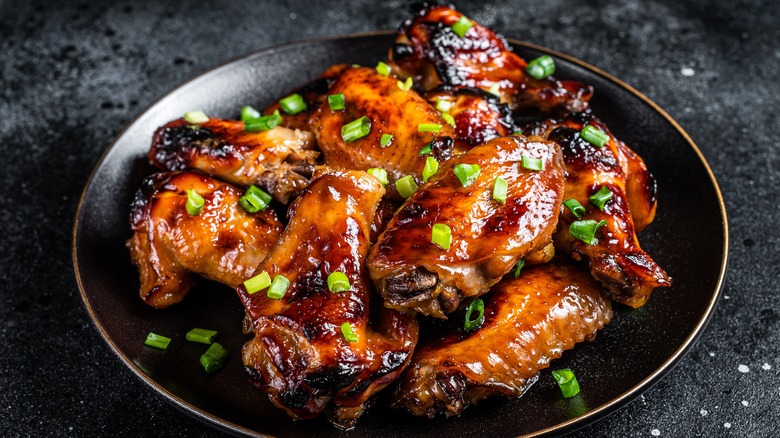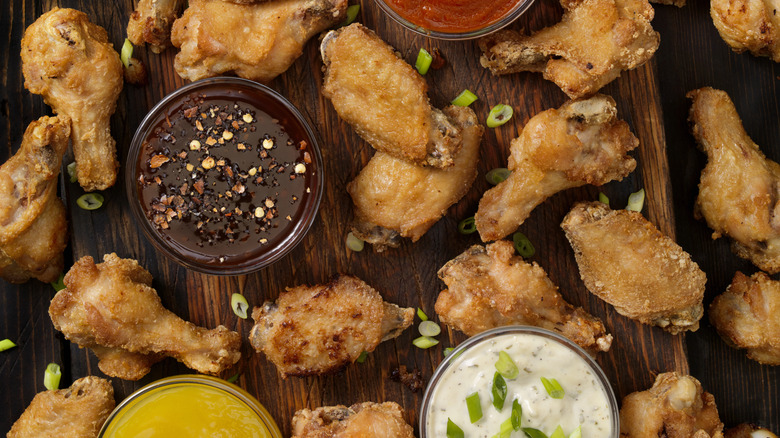How To Seriously Elevate Your Homemade Chicken Wings
Chicken wings just hit different. Even if you like white meat or legs, there's something about chicken wings that makes them special. They're crispier. They pack more flavor. They're versatile, convenient, and easy to eat. And even if you have them as a meal, they've got the fun, finger food appeal of snacking.
Maybe chicken wings are so good because they provide that added bone-in flavor you don't get with many other proteins. Maybe it's their saucy goodness, whether they're buffalo-flavored, garlic soy, barbecue, or something altogether different and amazing. Or maybe it's just because they're a social food and party staple. Even if you're indulging in them solo, you feel that festive vibe and energy, and they seem like more of a treat than a chicken wing or thigh might.
Whatever the case, we can all surely agree that chicken wings are one of the best-tasting, most enjoyable foods around. And here's the really great thing about them — you can easily make them even better! Whether you're dining on a package of frozen wings you picked up in the freezer aisle, or making your own from scratch, there are some easy tricks even a novice home cook can put to use to make a good plate of wings great! From the chicken you buy to start with to the way you prepare, to how you let it cook and crisp up, here are a dozen of our favorite secrets for seriously elevating any serving of homemade chicken wings.
Buy the best wings possible
To make a great plate of wings, you need to start with the best quality chicken possible. When shopping at your local grocery store, don't automatically just grab the first package of wings you see and continue on your way. Pause for a moment to give that package the once over.
Fresh, high-quality chicken wings should look plump and moist without any blemishes. The meat should have a pinkish hue — don't buy chicken if it appears slightly gray or slimy. Wings should also be completely intact with smooth skin. Avoid wings with tears, weird cuts in the flesh, or excessive bruising. You should also avoid any package of wings with a strong or noticeable odor, that appears excessively wet, or that has a lot of liquid in the package. Excess moisture is a sign the meat may not have been stored well.
If the wings are frozen, steer clear of packages with a large amount of ice crystals, too. This can be a sign they may have thawed and then been refrozen. Finally, check the expiration or sell-by date to ensure the wings are still within the window in which they should be used. And perhaps most importantly from a cooking perspective, make sure the wings in your package are all relatively evenly sized. This will help to ensure even cooking — nobody likes biting into a wing that's crispy on the outside but raw in the middle.
Prep like a pro
Like any meat, wings need a bit of love before they're ready for any spices or rubs you plan on using. Don't just open the package and dump it straight into your marinade. They won't taste as good, and you increase your risk for foodborne illness.
Step one in preparing any batch of raw wings is to dry your meat thoroughly. Although you might be tempted to wash it in the sink, don't. Washing raw chicken can spread any potential germs on the meat not just over the chicken, but throughout your entire kitchen. Instead, pat the meat dry with paper towels. If your wings came whole, now's also the time to grab a sharp knife and separate them into individual segments (drumette, wingette, and tip). Next, trim away any excess skin or fat around those individual pieces. And finally, check the flesh of each wing for any small bone fragments or feathers. Most butchers will catch these issues before releasing the wings for sale, but they can miss them occasionally, so it's better to find them now versus when the wing is cooked.
Season generously
Once your wings are prepped, it's time to bring on the seasoning. Rule number one: don't be stingy! Season your wings generously with a mixture of spices. You might use onion or garlic powder, different ground peppers, paprika, cayenne, cumin, chili powder, thyme, rosemary, sage, mustard powder, oregano, or even a flavored salt like celery salt. If you have a favorite blend of spices already in mind, combine them in bulk to create a dry rub you can use whenever you need in the future. While you can use herbs and spices with abandon, be cautious with any salt you choose; it's easier to add more later if needed than to correct an overly salty plate of wings.
As you season, be sure to coat all sides of the wings evenly for a well-balanced flavor. Get in there with your fingers and ensure spice is getting into all the various nooks and crannies. You can also mix freshly grated citrus zest into your rub or spice mixture, along with a bit of brown sugar for wings with a sweeter flavor profile.
Sometimes, spices will have trouble adhering if the chicken is especially dry. If you're having issues with this, spray your chicken with a small amount of cooking oil and then add your spices — it will help them adhere and create a flavorful crust.
Add baking soda for crispiness
Crispiness is one of the main selling points of any good helping of chicken wings. You want skin that is golden brown and firm, with a distinct smokey, brittle texture that crunches when you bite into it. Moist or soggy wings just won't do. One secret to making sure your wings pack plenty of amazing crispiness? Add some baking powder or cornstarch to your recipe.
While both ingredients have different uses in the kitchen — baking soda helps baked goods rise as they cook, while cornstarch is generally used to thicken sauces or gravies — they serve the same function when paired with chicken. Both help to reduce the amount of moisture on the skin of the chicken, while also raising its pH — in effect, jumpstarting the meat's browning process and helping to make it extra crispy.
To use either (you don't need both), add a small amount — around ½ teaspoon — to your spice mixture as you season your wings. Don't be too heavy-handed — neither ingredient tastes great on its own, so more isn't better. Make sure, too, that the baking soda or cornstarch is spread in a consistent, even layer over your chicken. Once in place, don't cook your wings right away. Instead, let them rest for about 15 to 30 minutes. This allows time for your spices to work their magic and also gives the baking soda or cornstarch time to draw out that surface moisture, for even greater crispiness.
Use a marinade
Marinades are an excellent way to make any meat, including chicken wings, more tender. To get started, you'll need a large, airtight container. Plastic food storage containers are a great option, as are giant-sized zip-lock bags. Before adding your chicken to either, grab a fork and poke each wing segment with it a few times. These pricks in the flesh of the meat will help the marinade soak in better.
Next, choose your marinade. You might opt for a simple mix of olive oil, lemon juice, black pepper, fresh thyme, and garlic. Or maybe you go with soy sauce, sesame oil, brown sugar, and ginger. Your options are unlimited — BBQ sauce, buttermilk, ranch seasoning, and garlic powder? Maybe even Dijon mustard, honey, cider vinegar, and fresh onion slices. Choose any flavor profile that appeals to you. The only rule is that it should include complementary flavors that work well together. Your marinade might have an acidic base like citrus or vinegar or a dairy base like yogurt or buttermilk. Choose one, then add whatever spices you'd like to round out its flavor profile.
Let your wings soak in the marinade for at least 30 minutes. You can marinade overnight, but you shouldn't go much longer. Also, don't marinate foods in aluminum containers — they can react to the acids and give your wings an unusual taste. And don't use too much salt in your marinade — saltiness intensifies over time, and a salty marinade can quickly leave wings inedible.
Fire up your grill
Everything tastes better cooked on a grill, and wings are no exception. Grilling imparts a wonderful smoky essence to wings that you just can't get with oil in a skillet. (Add hickory, mesquite, or applewood chips to your charcoal grill, and their flavor can be even more robust.) Grilled wings can also have an even tastier crust and are less oily than wings that are fried — there's no added oil to start with, and excess fat from the chicken simply drips away as the meat cooks.
For beautifully cooked wings every time, first start with a hot grill. Arrange your wings on oiled grill grates and let the meat sear for 2 to 3 minutes per side over direct heat. This creates those beautiful grill marks on the meat and also starts the formation of that crispy exterior we're all after. Once the wings are seared on both sides, lower the grill temperature slightly or move them to a slightly lower temperature area where they can continue cooking in more indirect heat.
Once all your chicken has that initial sear, cover your grill and let the wings cook an additional 5 to 10 minutes or until golden brown on the outside. If you have a meat thermometer, use it now. If the wings have reached an internal temperature of at least 165 degrees Fahrenheit, you'll know they're fully cooked. Let the wings rest for a couple of minutes after they come off the grill and serve!
Try an air fryer
There's a reason air fryers are all the rage in kitchens today: they're fast, they're easy, and they create minimal mess — three great reasons you should definitely consider using yours for your next batch of wings. Need another? Air-fried wings can be even crispier and better tasting than wings you fry in a skillet. There's less grease involved, and like grilling, excess fat from the meat can simply drip away. Best of all, that consistent blast of hot air ensures wonderfully even cooking all around each individual wing, meaning consistent crispiness on all sides. Plus, that circulating air creates a beautiful crust around the wings, locking in moisture and ensuring your perfectly cooked chicken is also nice and juicy.
For the best-tasting air-fried wings imaginable, make sure you always pre-heat your air fryer in advance. Wings should be nice and dry going in — give them an extra paper towel pat if necessary. Although you could use a batter or flour-coat your chicken, it's not necessary — a dry rub of spices or marinade pre-cooking is all your chicken really needs. Either way, don't overcrowd your fry basket. The wings should be in a single layer and not overlap for proper air circulation. Most importantly, don't forget to flip or shake your wings halfway through cooking to further ensure all sides of each wing are evenly browned and crisp.
If you fry, do it right!
Sometimes, the original way to do something is still the best. If you're still craving oil-fried chicken wings over wings cooked on the grill, in an air fryer, or baked in the oven, then do it like a pro! Great fried wings need to be dredged in flour — something you don't have to worry about with grilling or air frying. After seasoning your chicken, dip it in buttermilk or an egg wash of milk and eggs whisked together. Then, move the damp chicken into a container with a mixture of flour and additional seasoning and dredge it or shake it around until fully coated. You can "double dredge" or repeat this process twice for extra crispy wings. You can also add hot sauce to your liquid or a variety of herbs to your flour for added flavor.
Once your chicken is ready to fry, carefully place it in a skillet over medium-high heat. Your cooking oil should already be added and warm. Next, add just enough chicken to the skillet to fill but not overcrowd it. If you need to cook more, do it in batches. Once the chicken is perfectly browned on all sides, move it to a wire rack to drain instead of paper towels — this helps to further preserve that crispiness. Season again with a pinch of salt, let the wings rest so their juices can redistribute, and then serve!
Toss cooked wings in a finishing sauce
Love how wings you order in a restaurant or your favorite fast food place come all gooey and covered with thick, delicious sauce? Here's the secret. That sauce isn't cooked on. They add it after the wings are cooked. You can — and should — do the same thing when you cook wings at home, too.
You can use either a finishing sauce or glaze on any cooked wings. Sauces like buffalo or barbecue tend to have a semi-liquid consistency and provide a thicker coating on wings. Glazes, like a blend of honey and sriracha or maple syrup and bourbon, are even thicker and often leave a shiny glass on wings (hence their name).
Whichever you choose, pour about ½ cup of sauce or glaze per dozen wings into a bowl. You can use a basting brush to spread the sauce over your wings before serving. Or simply toss the wings in the liquid, much like you were tossing a salad in dressing. Your wings should be sauced almost immediately after they come out of the oven when they are still nice and warm. This will help warm the sauce or glaze and ensure it adheres beautifully to your meat. In general, it's better to use less sauce to start with rather than more. You can always add a second coat if needed, but you don't want your wings to be too messy and covered with excess sauce or glaze.
Double cook for extra crispness
Want chicken that is seriously crisp and crunchy? Then consider double-cooking those wings for that uber-crispy texture you're craving. Double cooking means precisely what it sounds like: you're cooking your wings twice, with a brief cooling period in the middle. The first time, you should cook your wings until they are almost done, but not quite. Let them cool a bit, and then start the cooking process all over for optimal crispiness.
For oil-fried wings cooked in a skillet, let your wings cool on a wire rack for at least 15 minutes. Then, reheat your oil and cook the wings again for an additional 3 to 5 minutes, or until they turn golden brown and are just the right level of crispy. For air-fried wings or wings cooked on the grill, do the same thing, but don't worry about letting the meat drain. Give the wings time to cool fully, and then "double cook" until perfectly crispened.
You can also use your broiler as your method of "double cooking" for any of these preparation methods. Let your wings cook and cool, pre-heat your broiler, and then put them under that intense blast of heat. This method is especially useful if you're adding a finishing sauce or glaze to your wings. The broiler will help that sauce to caramelize and thicken, turning even more sticky, intense, and satisfying.
Experiment with different flavor profiles
Classic buffalo flavor and barbecue sauce-flavored wings tend to be the most popular, but don't let yourself get stuck in these delicious ruts. There are many unexpected flavor profiles out there to try, and all of them can be incredibly delicious and refreshing when you're in the mood for something new.
For fruit-infused flavors, consider making mango habanero wings by pureing ripe mangoes with minced habanero peppers and a splash of lime juice. For tart, citrusy lemon pepper parmesan wings, simply melt some butter and add grated Parmesan cheese and lemon pepper seasoning. Or, for a sweet and spicy flavor explosion, try blending fresh or canned peaches with minced jalapeños, honey, and a touch of vinegar to create your own DIY Jalapeño peach wing sauce.
Want to go even bigger and bolder? How about a coffee ancho cocoa glaze made with butter plus a spoonful of instant coffee plus ancho chili powder, cocoa powder, and honey to taste? Or, go all out and make your own mustard maple bacon wings. Crumble some cooked bacon and combine it with your favorite mustard, plus a drizzle of maple syrup. Mix well, add your wings, and give them a good toss.
Don't skimp on dips
Once you have crispy, gorgeously sauced, hot, savory wings ready to dive into, don't just pour a cup of ranch dressing to dip them into and call it a day. The final secret to seriously elevating homemade wings is to always serve them with a variety of high-quality dips. Blue cheese and honey mustard are givens, so dig deep and get creative when thinking about what other flavors could help make those wings even tastier.
To make a garlic parmesan dip, you can quickly blend Parmesan cheese, minced garlic, and mayonnaise. Wings are also incredible with an avocado lime crema made by combining avocado, lime juice, sour cream, and a hint of cilantro. You can also pair wings with your favorite pre-made mango salsa, or whip up your own by mixing freshly diced mango, red onion, cilantro, and jalapeño.
For a bold flavor kick, create a wasabi aioli made with a mixture of mayonnaise, soy sauce, and the same wasabi paste you eat with sushi. Or, make a homemade maple Thai peanut dipping sauce with stuff you've likely already got hanging around in your fridge or pantry. Just grab a bowl and add ½ cup creamy peanut butter, 3 tablespoons soy sauce, 1 teaspoon minced garlic, and 2 tablespoons each vinegar, lime juice, and honey or maple syrup. For even more Asian flavor, add 1 tablespoon sesame oil, 1 teaspoon grated ginger, or 1-2 teaspoons Sriracha sauce. Whisk until smooth, and get ready to dip!

